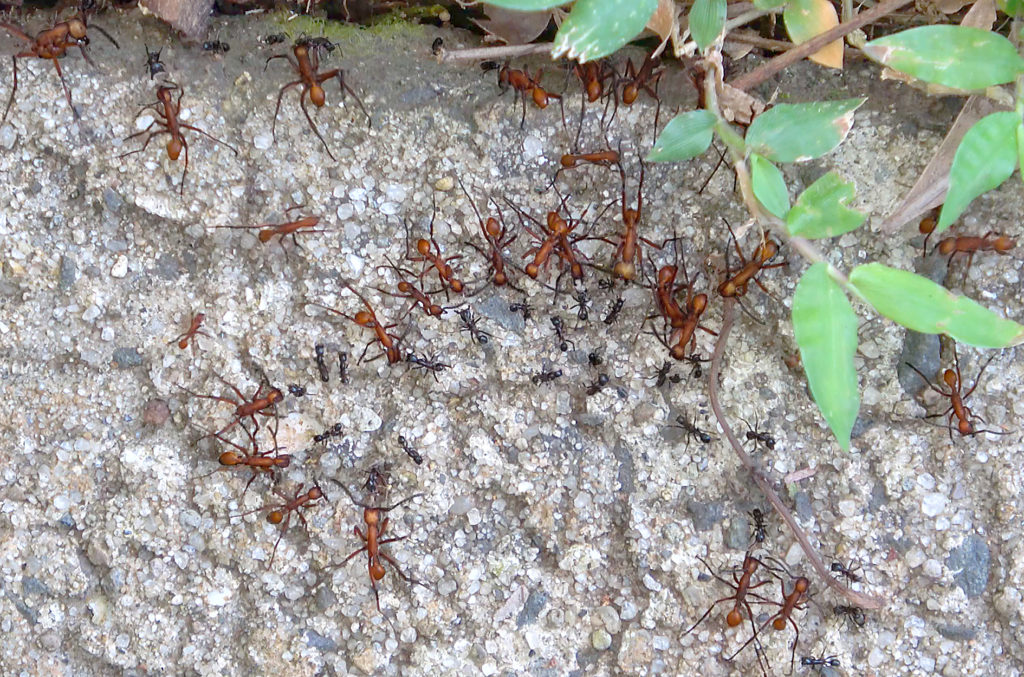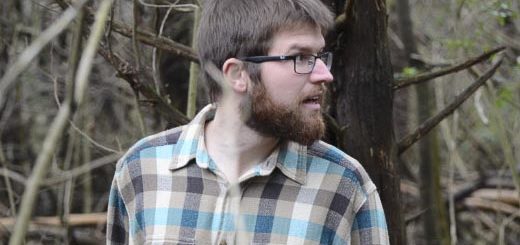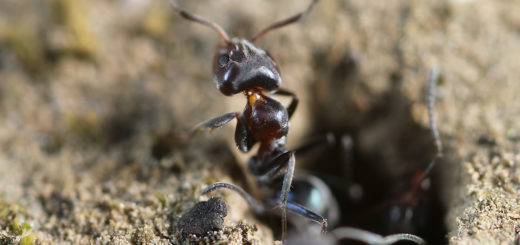Self-organized walls between Neotropical army-ant colonies
In the recent article “Incidental interactions among Neotropical army-ant colonies are met with self-organized walls of ants (Hymenoptera: Formicidae)” published in Myrmecological News, the authors Kaitlin Baudier and Ted P. Pavlic reveal that army ants form double-layered walls of individuals standing in a threatening posture when encountering another raiding army-ant colony. Here, Kaitlin answers some questions and shares some amazing pictures.
An Interview by Patrick Krapf and Felix Oberhauser

MNB: Could you tell us a bit about yourself?
KB: My name is Kaitlin Baudier. I am a postdoctoral research associate at Arizona State University, in the Social Insect Research Group. I study group behavior and physiological ecology of a variety of social insects, although I am particularly fond of Neotropical army ants. I worked on this project with one of my postdoctoral advisors, Ted Pavlic.
MNB: Could you briefly outline the research you published in Myrmecological News in layman’s terms?
KB: Among the variety of behaviors for which army ants are famous, perhaps the most apparent and charismatic are their group predatory foraging expeditions known as “raids” – but what happens when two army ant raids collide? Anecdotal evidence collected over the years suggests that raids avoid one another rather than engage in outright fighting. This makes sense because army ants do not prey on each other and because army ants are highly nomadic, that is they have no permanent territories to defend against one another. In this study, we sought to shed more light on how exactly this collective truce between colonies happens and how inter-colony reactions differ across species. On Barro Colorado Island in Panama, we artificially introduced army-ant colony fragments to non-nestmate raid columns and observed the result. In many cases, ants formed transient double-layered walls of individuals where a row of ants in one group faced a row of ants from the opposing group with all ants standing in a threatening posture. Given that the pace of these ants within their raids is normally frenetic, these stationary (albeit temporary) formations are particularly striking. At the individual level, video analysis suggested that high non-nestmate encounters may trigger the initiation of posturing and that low non-nestmate and high nestmate collisions stimulate the break-down of these walls of posturing ants once they are no longer needed (i.e., once there is no more contact between non-nestmates). However, we didn’t observe walling as a form of raid avoidance in all army ants. For instance, Nomamyrmex esenbeckii, the most belowground-active species in our study reacted to introduced colony fragments by biting, stinging, pinning, and dismembering the non-nestmates. We, therefore, speculate that walling avoidance may be a strategy predominantly used by aboveground army ants that are more likely to interact in normal ecological conditions. We also present anecdotal evidence that, in some contexts, aboveground army ants use similar (but unreciprocated) walling behaviors when they encounter leaf-cutting ants (Atta cephalotes).

MNB: What is the take-home message of your work?
KB: “Walling”, as we call it here, is just one of many interesting collective behaviors within the repertoire of army ants. Using just their own bodies they can also build bridges, fill potholes, link together to construct temporary living nests, and much more. One benefit of studying walling, in particular, is that it is easy to see what each different individual is doing throughout, and so we can more easily determine the individual-to-group level rules of how it works. However, at the end of the day, these different collective behaviors have a lot in common. Hopefully, our findings on how transient walls form and dissolve can be informative to the study of self-assembly and living construction in ants, robots, and beyond.
MNB: What was your motivation for this study?
KB: This study was part of a larger project (funded by the US Defense Advanced Research Projects Agency) which sought to expand our understanding of social-insect collective behaviors related to search and defense for application in various multi-agent systems. The transient walling we observed in army ants was of particular interest for this project because it is a context-dependent subroutine of foraging. Groups of robots are not very good at determining when to switch away from their primary task to start important secondary tasks, which is why it is useful to study how ants do it.
MNB: What was the biggest obstacle you had to overcome in this project?
KB: Trying to come up with a systematic way of dealing with highly variable field situations (not to mention famously temperamental ants) can be a real challenge. Although the methods we present are simple, there was a lot that went into their development.
MNB: Do you have any tips for others who are interested in doing related research?
KB: It’s hard to come up with tips that could be useful for what I see as a wide variety of possible related research projects. However, if you want to study army ants, I will say that it’s good to learn to enjoy a workday mostly filled with long, slow walks.
MNB: Where do you see the future for this particular field of ant research?
KB: As mentioned before, we are hoping that this work can inform new lines of thinking related to self-assembly and collective constructions in other ants, multi-agent robots, and beyond. Moreover, we hope this work will highlight novel research directions related to conflict de-escalation in co-existing social groups that must coordinate over access to common resources.
MNB: Thank you so much for this nice interview.

See als a virtual video talk that Kaitlin gave about this paper at the 2020 Animal Behavior meetings:






Recent Comments